Press Release Queen Mary 2 Maritime Quest ... - Creativematch
Press Release Queen Mary 2 Maritime Quest ... - Creativematch
Press Release Queen Mary 2 Maritime Quest ... - Creativematch
- No tags were found...
You also want an ePaper? Increase the reach of your titles
YUMPU automatically turns print PDFs into web optimized ePapers that Google loves.
<strong>Press</strong> <strong>Release</strong> <strong>Queen</strong> <strong>Mary</strong> 2 <strong>Maritime</strong> <strong>Quest</strong> exhibition © The Open Agency 2004
<strong>Queen</strong> <strong>Mary</strong> 2 <strong>Maritime</strong> <strong>Quest</strong>The <strong>Maritime</strong> <strong>Quest</strong>The largest permanent floating exhibition is here aboard the grandest ocean liner ever built, <strong>Queen</strong> <strong>Mary</strong> 2. The <strong>Maritime</strong><strong>Quest</strong> has been designed by The Open Agency and is a dynamic celebration of Cunard’s rich and illustrious past. It is thefirst time Cunard have commissioned a permanent exhibition of this magnitude and this truly wonderful experience willtake passengers back through Cunard’s proud and colourful heritage and show how closely Cunard are linked to keymoments in history.The 127 graphic panels, some over 8 metres long and covering over 500 sq.metres of the ship’s public access space ignitespeople’s imaginations as history unfolds before their eyes. Did you know it was a Cunard ship that picked up survivors fromthe Titanic, or that over 3 million migrants settled in the USA having bought tickets through Cunard offices throughoutmainland Europe before emabarking on their transatlantic route to a new life?The Open Agency researched, developed and designed the <strong>Maritime</strong> <strong>Quest</strong>, which has three distinct components: graphicpanels, interactive pods and an audio tour. The vast array of panels contain stunning visual imagery, vivid headlines andcarry an enormous amount of detail to keep passengers entertained and enthralled over and over again.“The largest permanentfloating exhibitionis here aboardthe grandest ocean linerever built,<strong>Queen</strong> <strong>Mary</strong> 2.”© The Open Agency 2004
<strong>Queen</strong> <strong>Mary</strong> 2 <strong>Maritime</strong> <strong>Quest</strong>The audio tour is a piece of theatre in its own right and is made up of about 60 spots, each around one minute in length.Each spot evokes scenarios and periods in Cunards history with narrative, humour, and first hand accounts. Having gatheredan enormous amount of content for The <strong>Maritime</strong> <strong>Quest</strong> we needed to establish which elements of the material would besuitable for interactivity – which elements could really be brought to life! Historical film footage, virtual tours, an enormouscelebrity database, puzzles and games are just some of the content that can be browsed through on the touch screen pods.“ ...covering over500sq. metres with127 panelsup to8 metres long each... ”The opening of the <strong>Maritime</strong> <strong>Quest</strong>, once <strong>Queen</strong> <strong>Mary</strong> begins her maiden voyage on 12th January 2004, will show twoand a half years of work come to fruition. Using a huge variety of narrative and visual archives from all over the world, theend result is enough raw material to bring together the biggest and best exhibition at sea the world has ever seen! TheOpen Agency have styled the exhibition to be constantly fascinating – interpreting the material in a very modern way withspecific reference to the human impact of the events that have taken place. The history of the Cunard Line is truly influentialin terms of modern history, especially of the relationship between America and Europe and the two world wars.Discover the man behind the name - Samuel Cunard - who noticed an advertisement in The Times in 1838 requestingtendors to carry the Royal Mail across the Atlantic. Share in the fear and excitement of some of the millions of emigrantsas they approach Ellis Island - the gateway to the new world. Listen to first hand accounts of survivors of the Titanic, asthe Carpathia saved all 700 lives. It is a fascinating insight on a grand scale. The world’s largest floating exhibition deliversa whole new experience for those travelling aboard Cunard’s greatest liner. There will also be a book published in thesummer summarising the exhibition available through openthebook.com.We are extremely proud of the <strong>Maritime</strong> <strong>Quest</strong> and look forward to sharing Cunard’shistory with our visitors when the ship launches in January 2004.”Pamela C. ConoverPresident and Chief Operating Officer, Cunard© The Open Agency 2004
<strong>Queen</strong> <strong>Mary</strong> 2 <strong>Maritime</strong> <strong>Quest</strong>It was whilst researching the <strong>Maritime</strong> <strong>Quest</strong> that the Open Agency discovered two fascinating elements of the CunardStory that has have led to the design, creation and publication of two new books that tap into, and add to, the heritage ofthe company:For over a century Cunard’s ocean liners have attracted superlatives to convey their size, elegance and style. As each newone was unveiled, people would describe her as ‘incomparable’ and Cunard would try to capture and illustrate thesefeelings of awe and admiration by comparing her with her predecessors and with land-based feats of art and engineering.<strong>Queen</strong> <strong>Mary</strong> 2 – Book of Comparisons follows in this tradition and traces the journey from her inception, through herimpressive design and build, to finally steal a glimpse at what it takes to run the worlds largest ocean liner. See how thesize and shape of its hull compares to a school of blue whales; which buildings are as tall as the <strong>Queen</strong> <strong>Mary</strong> 2 is long, andwhat iconic detail it shares with British Airways London Eye.Each one of the 20 comparisons is beautifully brought to life by award winning illustrator Andrew Davidson and, issupported by some of the original archived images from earlier Cunard books. The text has been compiled by researcherand author Elspeth Wills who has also been a major contributor to the <strong>Maritime</strong> <strong>Quest</strong> exhibition. The <strong>Queen</strong> <strong>Mary</strong> 2– Book of Comparisons, like its predecessors, stands as a testimony to human achievement.Stars Aboard is a collection of wonderful images brought together for the first time, many not shown in public before.They were taken on board the <strong>Queen</strong> <strong>Mary</strong> and <strong>Queen</strong> Elizabeth during the golden age of ocean travel in the 1930s, 40sand 50s. Elizabeth Taylor, Clarke Gable, Charlie Chaplin and Marlene Dietrich to name a few endorse the Cunard name.Both books are available through openthebook.com (where you can download sample pages), or directly fromThe Open Agency on 020 7740 7000.© The Open Agency 2004
The two <strong>Queen</strong> <strong>Mary</strong>s QM Maiden Voyage042 DECK 2Academy at SeaOn May 27th 1936, the <strong>Queen</strong><strong>Mary</strong> left Southampton at 4.30pmon her maiden voyage via Cherbourgto New York, to the sound of theRoyal Marines playing ‘Rule Britannia’.More than 100 journalists plusrepresentatives of the BBC andother networks were aboard torecord their impressions. Amongthose aboard were AmbassadorJoseph P Kennedy’s wife, Rose;designer Cecil Beaton; actressesFrances Day and Anita Louise andcomposer Jules Stein.The telegraph from the bridge to the engine room rang:The steam valves did not require to be touched againuntil the <strong>Queen</strong> neared New York.The pressure mountsAs well wishers were called backashore, in the engine room,pressure and temperature gaugeswere rising: the shipside doorswere shut. In the wheelhouse, thepointer rested on ‘Slow SpeedAstern’, while the clanging of bellsindicated that the ship was now inmotion. A tug slowly guided her outof the harbour, gently manoeuvringher toward the sea.Mistakes are madeBy late afternoon the <strong>Queen</strong> <strong>Mary</strong> arrived in Cherbourg Harbourwhere a special building had been constructed to serve as the dock andport of entry to the ship. Its gangway was designed to fit precisely into theshipside door so that new passengers could simply walk aboard. Due to amiscalculation, however, it slid six feet short and a makeshift plank hadto be used to close the gap between the end of the gangway and the ship.‘You’d hear her hooter off down by the Isle of Wight… the next thing you’dsee her funnels almost standing in the High Street… very impressive.’Winifred Wilton Southampton ‘...the people of the city joined in giving her a royal welcome.She accepted the homage of lesser craft with gracious dignity,responding to the shrill salutes with her deep throated voicetwo octaves below middle A.’As reported in the New York Times RapturesThe New York welcome was farmore informal than Southamptonbut still as raptuous. <strong>Queen</strong> <strong>Mary</strong> 2 <strong>Maritime</strong> <strong>Quest</strong>Cunard History“Half Speed Ahead”...“Full Speed Ahead”...“Full Ahead”...A great friendship beginsOn the morning of June 1st 1936, a fleet of vessels representing theNavy, the Coast Guard, over-crowded ferries and private yachts metthe <strong>Queen</strong>. Fire service boats used their water hoses to create a seriesof fountains along the river, and aircraft circled overhead. clockwise from top left: <strong>Queen</strong> <strong>Mary</strong> enters New York on her maiden voyage,the race for the prestigious Blue Riband, and the story of <strong>Queen</strong> Elizabeth.© The Open Agency 2004
Cunard Carpathia and the TitanicTimeline of Events017 DECK 5C StairwellOn April 13th 1912, Cunard LinesCarpathia set off from New York,heading east across the Atlantictowards Gibraltar on a routinejourney to the warm climes of theMediterranean, scheduled to arriveat the British colony on April 20th.Fate, however was to deal theCarpathia a very different hand.The Titanic of the White Star Linewas at the time on its much heraldedmaiden voyage, setting off fromSouthampton on April 10th, andafter picking up in Cherbourg and<strong>Queen</strong>stown turning east headingtowards New York.The Marconi Wireless technologywas still very much in its infancy, anda real selling point to passengers, asseen here (right) in the Carpathiabrochure. Indeed it would prove tobe more important than perhaps evenMarconi himself could have imagined.Harold Cottam, wireless operatoron Cunard’s Carpathia, steamingacross the Atlantic from New Yorkto Gibraltar, spent the evening ofApril 14th in regular touch withseveral vessels, one of which wasto become a legend, the Titanic.Cottam was about to go to bedwhen he picked up a message to theTitanic from Cape Cod warningthat ice was about. Knowing Phillips,the Titanic wireless operator,Cottam radioed him to check thathe had got the message. The answerthat came back was unexpected.‘We have struck ice...Come at once.’(Caronia to Titanic)(Noordam to Titanic)“Icebergs and large quantities of fieldice in 41o to 51oN, 49o to 52oW...wish you and Titanic all success”(Baltic to Titanic)(Californian to Antillian, overheard by Titanic)(Mesaba to Titanic)(Californian to Titanic)North of the Titanic, theTitanic hits the iceberg with aCalifornian is stopped in an glancing blow, a last-second swingice field, and sends out a warning to port is just not enough to avoidto all vessels in the area. This the collision. The impact is jarringwarning is not received well by the to the crew down below in theTitanic radio operator, and he forward area, but most people ontells the Californian to ‘Shut up! the ship do not notice the collision.You are jamming my signal.I am working Cape Race.’(Carpathia to Titanic)Captain Smith gives the order touncover the lifeboats, and to beginto muster the passengers and crew.The water is now flooding the squashcourt, 32 feet above the keel. (Titanic to Carpathia)Wallace Hartley, and the membersof the Titanic’s band, begin toplay a medley of ragtime tunes inthe first class lounge on ‘A’ deck.Later, they move up to the boatdeck near the port-side entranceto the grand staircase.Captain Smith now gives the orderto load the lifeboats, women andchildren first. The Cunard Line’sCarpathia, some 58 miles to thesouth, picks up Titanic’s distresscall, and begins to steam at fullspeed northward to effect a rescue.(Carpathia to Titanic)(Titanic to Carpathia) (from Titanic)The bow has sunk enough for thewater to lap around the letters ofthe name Titanic, and the shiptakes on a list to port. This spurson both the crew and thepassengers, and the lifeboats beginto leave Titanic with more andmore people aboard.(Titanic to Frankfurt)(Carpathia to Titanic)Port-side lifeboat No.14 beginsto be lowered, and a group ofpassengers appear to be ready tojump into the already full boat.Officer Lowe takes his revolver,and fires a few warning shots whichseem to have the desired effect, asthe crowd steps back.(from Birma)(from Titanic)(Frankfurt to Titanic)The fast-approaching Carpathiahears Titanic’s ‘last words’,‘…engine room full up to boilers…’Port-side lifeboat No. 2 leaves with25 people aboard, in a boat madefor 40. One of the last lifeboats now Captain Smith realises the end is A huge roar engulfs Titanic, The stern section begins to settleremaining is Collapsible ‘D’ which near. He tells the crew that it's possibly made by the contents of deeper in the water and as it fills, thehas room for 47 people, but there ‘every man for himself’, and he the ship sliding downwards. The stern rises high out of the waterare over 1,500 people still left on makes his way to the bridge to ship’s lights, which had keptagain, before slipping out of sight.the ship. To prevent a rush for the await his fate. Thomas Andrews, burning bright for so long, flicker, Titanic is finished, but for overboat, Lightoller instructs some of the ship’s designer, is last seen and finally go out. The ship breaks 1,500 people, death will be an hourthe crew to form a ring around the alone in the first class smoking in half, and the bow sinks, while the or so away. Hypothermia, ratherboat, and he also waves, and room.The band cease to play, and stern of the vessel seems to almost than drowning, is the main causepossibly fires, his gun.the first funnel collapses, crushing right itself.of their passing.many people already in the water. Safe at lastAt 8.30am the very overloaded No.12 lifeboat pulled alongsidethe Carpathia: 30 minutes later, the last of the 703 survivors outof the 2101 passengers and crew of the Titanic stepped aboard.The Carpathia eastbound for the Mediterranean turned back toNew York, docking at her Cunard pier to be met by coronersand coffins. The four day journey had been extremly cold,followed by sunshine, thunder, fogs, rain and chop. She towedsome of the Titanic’s lifeboats behind her, others having beenhauled up into her davits.Carpathia has been speedingtowards the last radioed positiongiven by Titanic, but upon herarrival, there is nothing to see atfirst. But then, a green flare is seenahead, low in the water. Captain Rostron ordered the Carpathia picks up the firstengines of his ship stopped. All lifeboat, No.2, and a First Classof Carpathia’s crew werepassenger Elizabeth Allen was thedesperately straining to see some first to be taken aboard. Due toclues, some wreckage, or even the threat posed by all of thesome survivors, in the early morning surrounding ice, Carpathialight. Suddenly, one of the crew must pick her way very carefullyspotted a green light low down through the ice.ahead in the water. It was a flarefrom out of the lifeboats! The reluctant heroIn 1926, Captain Rostron was knighted, just one of theinternational accolades he received to make him among themost decorated ship’s captains in the world. He was alwaysmodest and reluctant to talk of his role.‘We steamed at full speed and did what we could. It wasterrible. I don’t like to dwell on the awful scenes. I would saythis only, the commander of the Titanic was a courageousman who was blamed unjustly and unnecessarily.’When asked by a reporter about the degree of difficultyof running the Carpathia at near full speed in the darkthrough a field of icebergs Rostron told him: The last lifeboat to be picked up Carpathia now heads for Newby the Carpathia is No. 12, and York, carrying a mere 705Lightoller is the last man out of it. survivors from the Titanic. IsmayThe Californian now arrives close sends a message to New York’sto Carpathia, and steams around White Star offices; ‘Deeply regretfor a while in a futile search for advise you Titanic sank thissurvivors.morning after collision with icebergresulting in serious loss of life. Fullparticulars later.’<strong>Queen</strong> <strong>Mary</strong> 2 <strong>Maritime</strong> <strong>Quest</strong> Cunard History9.00am April 14 th“Bergs, growlers and field ice in 42 o N, from 49 o to 51 o W”11.40am April 14 th“Much ice”1.42pm April 14 th7.30pm April 14 th“42 o to 3’N. 49 o to 9’W. Three largebergs 5 miles to the southwards of us”9.40pm April 14 th“42 o to 41 o 25’N, 49 o to 50 o 30’ saw much heavy pack ice and greatnumber of large icebergs, also field ice, weather good, clear”10.30pm April 14 th“We are stopped andsurrounded by ice”10.32pm April 14 th“Shut up! You arejamming my signal.I am working Cape Race”(Titanic reply to Californian)10.55pm 11.41pm12.00pmApril 14 th12.01am April 15 th“I say, old man, do youknow there is a batchof messages comingthrough for you fromMCC (Cape Cod)?”12.05am12.05am April 15 th“Shall I tell my Captain?Do you require assistance?”(Carpathia to Titanic)“Yes. Come quick!”12.15am12.25am1.20am April 15 th“Get your boats ready. Going down fast by the head”12.30am April 15 th1.40am April 15 th“We are coming. You are only fifty miles away.Hope you are safer I am”“SOS”12.30am April 15 th“Do you need any special boats to stand by?”12.30am April 15 th“we need all the boats we can get!”1.15am1.41am April 15 th1.35pm April 15 th“Starting for you”(Frankfurt to Titanic)1.20am April 15 th“Are you still there? We are firing rockets”“CQD. Boilers flooded…engine room full up to boilers”1.41am April 15 th“Are there any boats around you already?”“all quiet”1.41am April 15 th(from Carpathia)1.30am 1.45am2.05am 2.17am 2.18am 2.20am3.30am4.00am4.10am‘Someone else’s hand otherthan mine was on the wheelthat night’8.30am8.50amtop & middle: The scale and size of Cunarders through the agesbottom: The Carpathia reacts to the cry for help from the Titanic.© The Open Agency 2004
Cunard at War The Lusitania056 DECK 2Area B StarboardIn 1903 the Admiralty made anAgreement with Cunard to financethe whole of the building costsfor two new luxury liners -Mauretania and Lusitania.In return Cunard agreed to buildships capable of maintaining aminimum average ocean speedof 24 to 25 knots.With annual subsidies reduced from£240,000 to £75,000 per vessel,Cunard needed to dramaticallyincrease passenger accommodationand decreed a spaciousness andsplendour of accommodationhitherto unknown outside the greatluxury hotels of the world... higherin fact than anyone had ever builta ship before.As laid down in the Admiraltycontract, the outbreak of the FirstWorld War meant that theCunard ships were requisitionedfor military service. TheMauretania served as a troopship and was attacked by a U-boat,her speed allowing her to avoidbeing torpedoed. She then becamea hospital ship until requisitionedonce more for transporting troopswhich she continued to do afterthe war.The Mauretania’s sister ship theLusitania met a sadder fate...‘Grand Hotel’ at seaThe Lusitania became the first'Grand Hotel' at sea, completewith Palm Courts, orchestras,a la carte restaurants, electriclifts, telephones and even a dailynewspaper printed at sea. She wasa 762-foot long passenger linerwith four raked funnels set on awhite gleaming superstructureand painted in the Cunard livery.Cunard at War Churchill and Cunard000 DECK 2Academy at SeaChurchill and the <strong>Queen</strong> <strong>Mary</strong>May 5-11, 1943Winston Churchill transported from Gourock in Scotland toNew York, to meet with President Roosevelt. Below deck5,000 German prisoners of war were being transported to theUS to sit out the remaining part of the war.August 5-9, 1943Winston Churchill transported from Gourock to Halifax,Canada, for 2nd Quebec ‘Quadrant’ conference. Churchillcrossed to Quebec on the <strong>Queen</strong> <strong>Mary</strong> for the D-Dayplanning conference. He had with him models of the artificialharbours to be used on the beaches of Normandy. With anAdmiral making waves in the bathtub, Churchill spent so muchtime testing the models; Mrs. Churchill was forced to bathenext door.August 27-31, 1943Winston Churchill returns to Gourock with 15,116 troops.June 6, 1944D-Day Invasion of Europe.Under protection of the flag ‘The Lusitania is to be torpedoed...’Trouble in the zoneOn May 1st, 1915, the Lusitania Before departure, some passengers received a telegram stating that the On May 7th, 1915 with 1959left New York under the US flag Lusitania would be attacked on her last voyage departing from New passengers and crew aboard, thewhich it was thought would protect York. One sent to Alfred G Vanderbilt, the American millionaire due to Lusitania entered the U-boather from U-boat attack as the US travel on the ship read:zone. An alleyway in the Irish seahad not entered the war.where U-boats were known to lay‘Have it on definite authority the Lusitania is to be torpedoed.in wait. The ship was torpedoed atYou had better cancel passage immediately.’ Signed: Morte’2.10pm on the starboard stem.These telegrams were the beginning of a conspiracy theory that Churchill Causing a large explosion.was conspiring a situation to bring the US into the war.Double troubleThe sinking sparks rumours of conspiracyA few seconds later a second The rumour stories continued with some people suggesting thatexplosion rocked the ship: it was Winston Churchill, as Minister of Transport wanted the Lusitaniathought likely that she was secretly sunk to attract more countries to the allied cause.carrying munitions, aluminium or‘At the summit true politics and strategy are one. The manoeuvremagnesium for the war effort inwhich brings an ally into the field is as serviceable as that whichEurope, and it was these that hadwins a great battle. The manoeuvre which gains an importantignited. Listing to starboard shestrategic point may be less valuable than that which placates orhampered the launching of lifeboatsoverawes a dangerous neutral…’and sank in about 18 minutes.1,201 men, women and children Churchill’s autobiographical account of WW1lost their lives.Above: <strong>Queen</strong> <strong>Mary</strong> carryingover 15, 000 troops on one voyageRight: <strong>Queen</strong> <strong>Mary</strong> arrives atSydney in 1940Was the Lusitania onlya passenger ship?It was discovered after the sinkingthat, as well as passengers, theLusitania had carried among herdeclared cargo, 4,200 cases ofsmall arms ammunition and1,259 cases of steel shrapnelshells, plus 3,863 boxes of cheeseand 696 tubs of butter destined forthe Naval Experimental.Right Cunard munitions factoryConference CallTravelling under the assumed name of Colonel Warden,Churchill himself journeyed to three wartime conferences inNorth America aboard the fast <strong>Queen</strong> <strong>Mary</strong>. If he was onboard, some of the cabin-class suiteswere temporarily restored to theirpre-war condition.On the Kerry coast,Ireland, searchers scouredthe jetsam of successive tides,spurred on by the financialincentives officially announcedby Cunard and anxious relatives.An ‘ordinary’ body earned £1,an American £2, and a jackpot of£1,000 was offered for the remainsof millionaire Alfred Vanderbilt.Above A survivor is helped ashore‘Geschaft uber alles’The sinking of the Lusitania was seenby the German Government as a victoryin the context of war. Fifty special medals wereawarded to those aboard the U-boat that dealt thefatal blow. The medal carries the legend ‘Business aboveall’, and features a skeletal figure sitting at a Cunardbooking office distributing tickets to thosewho refuse to attend to the warning againstsubmarines given by a German. This pictureseeks apparently to propound the theory thatif a murderer warns his victim of an intent tomurder, the guilt of the crime will rest with thevictims ignorance, not the murderer.Allied condemnationIn Britain the medals were viewed as theGerman’s celebrating the death of innocentcivilians. A leaflet and several thousandreplica medals were struck and distributedas propaganda tools.Honourary PassengerProven a very sturdy and reliable ship, the Franconia wasgiven a very honourable task in 1945. Top secret orders fromabove ordered the Cunarder to the Mediterranean after she hadsome of her luxury fittings taken from storage and re-installed.When in the Mediterranean, the Franconia was sent furtheron into the Black Sea where she would serve as the floatingheadquarters for the British Prime Minister Winston Churchilland his staff during the historical Yalta Conference.Prime Minister Churchill was given a series of suites, while thestaff; including secretaries, telegraphers, typists, and securityguards – in all over a hundred people – joined him in lessornate environments. Cunard knew how to treat Churchill andsince he liked spending much time in the bathtub, they installeda shelf just next to the tub, offering the Prime Minister to workand enjoy the soaking at the same time.Left: Maiden voyage of the <strong>Queen</strong>Elizabeth alongside <strong>Queen</strong>Elizabeth and MauretaniaRight: Franconia IIFar right: War brides heading toAmerica aboard the <strong>Queen</strong> <strong>Mary</strong> <strong>Queen</strong> <strong>Mary</strong> 2 <strong>Maritime</strong> <strong>Quest</strong>Cunard HistoryLuxury Liner......or Secret Warship?‘...a crime that has staggered humanity’ ‘... then came the worst part. We were alone. Thespace a few moments ago occupied by our luxurioushome was a ghastly blank of almost still water’.Cunard History ‘Built for the arts of peace and to link the Old World with theNew, the ‘<strong>Queen</strong>s’ challenged the fury of Hitlerism in theBattle of the Atlantic...Testing the BathtubAt a speed never before realised in war,they carried over a million men to defendthe liberties of civilisation. Without theiraid the day of final victory mustunquestionably have been postponed.To the men who contributed to thesuccess of our operations in the yearsof peril, and to those who broughtthese two great ships into existence,the world owes a debt of gratitude.’ War has played a large part in Cunards history, since the days of the Crimea.clockwise from top left: The Wonder ship Lusitania, the dazzling war paint of theMauretania in First World War, Official War Artist Linda Kitson records events on boardthe QE2 during the falklands conflict, Winston Churchill on board the <strong>Queen</strong> <strong>Mary</strong>.© The Open Agency 2004
Behind the Scenes The scale of the jobFwd StairwellThe ApprenticesYoung lads exchanged the schoolplayground for the shipyard. ‘... theforeman took one look at my shorttrousers and told me to go home andget a pair of long trousers and comeback in the afternoon. And so I wenthome and ma mother made me a pairof trousers out of an old coat.’Joe Boyd, apprentice, 1930sFred McCarron, RiveterThe Riveters‘ The boy throws the hot rivet to theholder-on and he picks up the hot rivet,sparking hot and rams it through thehole wi’ a back-hammer. The riveterdrives it in wi’ alternate blows on theoutside of the shell.’Riveter, 1930sThe ManagementThe Foremen who worebowler hats were known as‘B*****ds in Bowlers’.Description by John BrownThe Bankies -Clydebank WorkforceBuilding a great ship was anincredibly hard, dirty and noisyjob as well as requiring skilland teamwork.Until the Second World Warat least, most shipyard jobs weredirty, dangerous, noisy anddemanded great physical strength.D. Vance, Fitter The PlatersPlaters and other pieceworkerswere known as ‘the black squad’because of their dirty clothes andfaces: in the days before safetyclothing, they wore ‘old patchedtrousers with a dirty cardigans, an oldjacket with the elbows out, a mufflerround the neck and maybe an oldbunnet.’Plater, 1930s D. Chalmers, Holder-On <strong>Queen</strong> <strong>Mary</strong> 2 <strong>Maritime</strong> <strong>Quest</strong>Marine & Nautical 000DECK 4‘...the human fingerprints on a great ship’‘ Is my work hard?‘ I’ve filled out moreYes of course it’sliners than you’vehard. But I wishgot fingers - andthey’d hurry upfitted ‘em outand give us anotherwell, too.’ship to build.’‘ Holder-on, that’sme. What notknow what aholder-on is!Where did theybring you up? ’ John Browns shipyard on Clydebank played a major part in creating the great Cunard liners.© The Open Agency 2004
Interactive touch screen examples<strong>Queen</strong> <strong>Mary</strong> 2 <strong>Maritime</strong> <strong>Quest</strong>© The Open Agency 2004
<strong>Queen</strong> <strong>Mary</strong> 2 <strong>Maritime</strong> <strong>Quest</strong>© The Open Agency 2004
<strong>Queen</strong> <strong>Mary</strong> 2 <strong>Maritime</strong> <strong>Quest</strong>Thank you......for taking the time to browse through this extract of The <strong>Maritime</strong> <strong>Quest</strong>. For more information please contact:Mike Horseman or Simon Runton on 020 7740 7000The Open Agency LtdMill House8 Mill HouseLondonSE1 2BAwww.openagency.com© The Open Agency 2004








